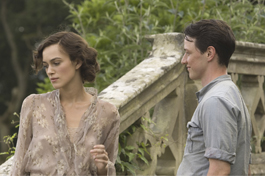home | metro santa cruz index | movies | current reviews | film review

Photograph by Alex Bailey
PLAYING KNIGHTLEY: Keira Knightley plays an Art Deco object of desire for James McAvoy in 'Atonement.'
Mistake Prone
The characters in 'Atonement' keep paying for their errors all the way through World War II
By Richard von Busack
The very title is so forbidding I'm surprised no one has chosen it for a literary magazine. Like the original, the film version of Ian McEwan's novel Atonement takes place on two vastly different summer days. The first half unfolds in a British manor in 1935. It delves so far into the world of upper classes that I excepted Jeeves to wander in.
The turning point of the plot is, essentially, a Bertie Wooster mistake. During a heat wave on a weekend, young Robbie (James McAvoy) gets into a scrape. He's the cook's son who is practically a member of the wealthy Tallis family of Wiltshire. Recognizing his talent, the Tallises have sent him to school. Now he's begun to notice young Cecilia (Keira Knightley), just back from college. They have a small disagreement; a precious vase gets broken. Cecilia strips and dives into the family's fountain to taunt Robbie a little.
Later that day, Robbie writes a small note of apology, which he foolishly gives to Cecilia's prying little sister, 13-year-old Briony (Saoirse Ronan). Worse, he accidentally gives Briony the first draft of the note, composed in midswoon after seeing Cecilia clad in a wet slip. In a candid few sentences, he describes what he'd like to do to her if he could. This note leads to thorough disaster, implemented by Briony's fervent imagination. (The book hints that this imagination will be the girl's fortune; essentially, she'll grow up to be Dame Iris Murdoch.) After the calamity, Atonement heads to World War II, where Robbie, now a wounded soldier, atones for his mistake the hard way.
As in Brideshead Revisted, the twitty, lounging English upper-class types show their steel during the war. And yet they also commit unforgivable atrocities against those of us who drop our aitches. The success of the movie will be due mostly to the unfussy way director Joe Wright portrays interwar manor life.
Wright is reunited with his star from Pride & Prejudice, the petulant, desirable Keira Knightley: here she has a blue-blooded lockjaw. Knightley's body, as slender as any Art Deco icon, is draped in backless green silk. The color is hard to carry off, but the purpose of it is revealed when heat and desire redden Cecilia's skin.
Similarly, the casting of Ronan has the right kind of uncanniness. She possesses the crystalline eyes of one of the Children of the Damned. It makes sense that this budding writer would grow up to be Vanessa Redgrave in the film's coda, although I hated the coda. It's another postmodern ending that expresses, actually, nothing you would ever need to hear expressed regarding the difference between fiction and real life.
The seriousness of life—as opposed to the artificial paradise of the Tallis' manor—is expressed vividly in the second half, anyway. Reversing the usual pattern, Wright uses a swift, hand-held camera in the manor and majestically composed scenes for the warfare. The early scenes have the darting camera as Briony deals with a gaggle of unwanted cousins; it's there for the instant that Briony catches Cecilia in midcoitus, splayed out like a starfish against the library wall.
The real art comes in the later scenes, with Robbie's march to the English Channel with the fleeing British Expeditionary Force. During these scenes, McAvoy advances to the lead rank of English film stars. The revealing shot of the terminal beach at Dunkirk is a stunner. We see the thousands of milling soldiers, junking their trucks and shooting the horses so that the Nazis won't have them. Amid the destruction, the remains of hallucinatory beachfront attractions still stand. A brawl breaks out in a gutted cafe. A choir practices in a gazebo amid the lolling or marching wounded, with a tattered Ferris wheel in the background. It's like The Longest Day meets the art of Belgian symbolist James Censor. The sequence is Atonement's finest moment.
Whether the film transcends the formality of the book is another matter. Atonement starts with a clacking typewriter. It's such a sinister mechanical sound to younger ears, and it becomes the drum track in the title music. The racket of the keys on paper, during the title theme, gets us ready for the moment later when Robbie types up the terrible four-letter word that dooms him. (All The President's Men is the last time we had such a typewriter of doom, with every letter sounding like a tympani being struck.) This clacking is the emblem of a seriously engrossing but repeatedly overdetermined film. In Atonement, we can't seem to get away from the idea that this is a story, just words on paper.
![]() ATONEMENT (R; 130 min.), directed by Joe Wright, written by Christopher Hampton, based on the novel by Ian McEwan, photographed by Seamus McGarvey and starring Keira Knightley and Saoirse Ronan, opens Friday at the Nickelodeon in Santa Cruz.
ATONEMENT (R; 130 min.), directed by Joe Wright, written by Christopher Hampton, based on the novel by Ian McEwan, photographed by Seamus McGarvey and starring Keira Knightley and Saoirse Ronan, opens Friday at the Nickelodeon in Santa Cruz.
Send a letter to the editor about this story.
|
|
|
|
|
|